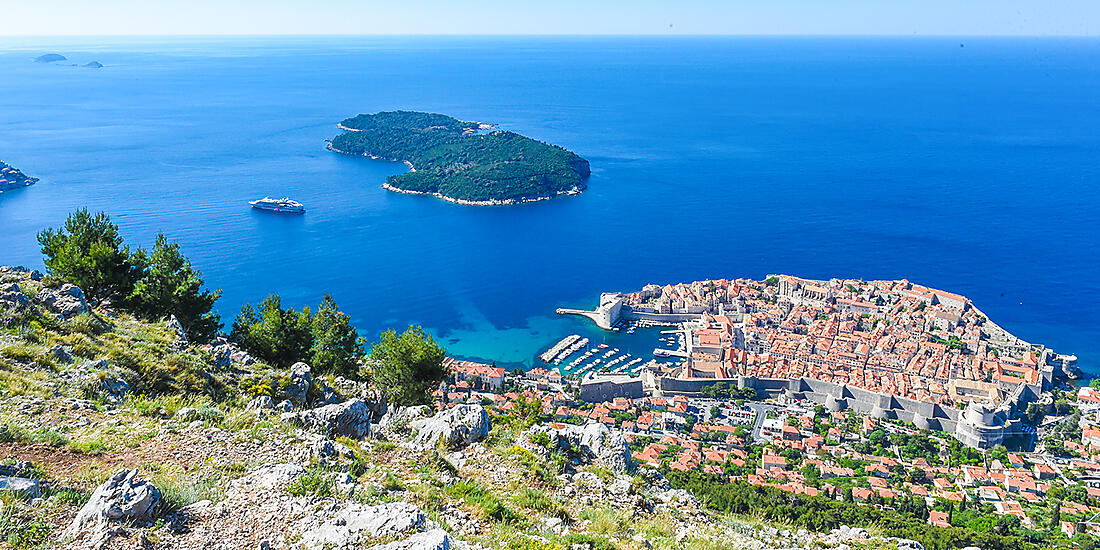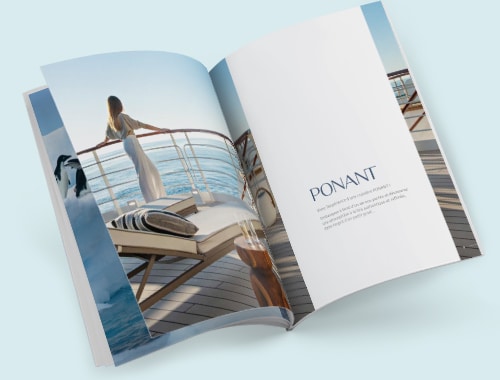Gründe, mit PONANT ins Mittelmeer zu fahren
Das Mittelmeer umfasst mit seiner reichen Geschichte und seinen unterschiedlichen Kulturen einzigartige Orte und besticht durch ein unvergleichbares Lebensgefühl. Eine Kreuzfahrt im Mittelmeer ist der ideale Weg, um diese bereichernde Vielfalt hautnah zu erleben.
Mehr
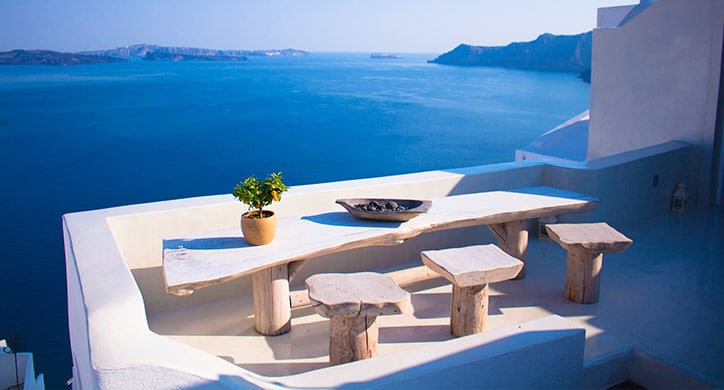
Die schönsten Highlights des Mittelmeeres
Angesichts der vielen Facetten des Mittelmeers ist es nicht einfach, bestimmte Regionen gegenüber anderen zu bevorzugen. Wir haben einige Highlights im Mittelmeer zusammengestellt, von Besichtigungen kultureller Stätten bis hin zu Orten der absoluten Entspannung, die man zumindest einmal gesehen haben sollte.
Mehr
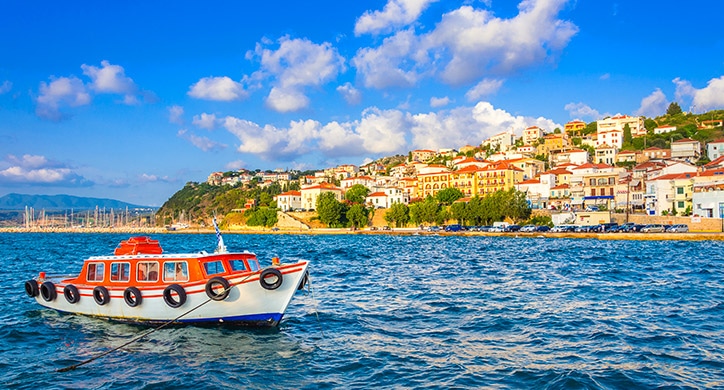
Explore the Mediterranean
3 Gründe, mit PONANT ins Mittelmeer zu fahren
Das Mittelmeer umfasst mit seiner reichen Geschichte und seinen unterschiedlichen Kulturen einzigartige Orte und besticht durch ein unvergleichbares Lebensgefühl. Eine Kreuzfahrt im Mittelmeer ist der ideale Weg, um diese bereichernde Vielfalt hautnah zu erleben.
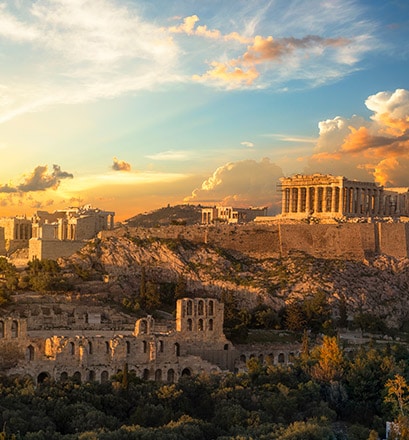
Eine reichhaltige Geschichte und UNESCO-Stätten
Das Römische Reich, das antike Griechenland, das Osmanische Reich... Seit der Antike versuchen die Menschen den Mittelmeerraum unter ihre Herrschaft zu bringen und die Seewege zu kontrollieren.
Noch heute zeugen die zahlreichen UNESCO-Welterbestätten vom wirtschaftlichen und kulturellen Reichtum und der Vielfalt der Völker des Mittelmeerraums.
Bei einer Kreuzfahrt im Mittelmeer können Sie die Akropolis von Athen, das Theater von Epidauros, die heilige Insel Delos, die antike Stadt Nessebar, die Ruinen von Delphi, die mittelalterliche Stadt von Rhodos, die historischen Zentren von Valletta, Dubrovnik, Kotor und Syrakus, die Überreste von Pompeji, Rom oder auch Venedig bestaunen. Das Mittelmeer wartet mit unzähligen Juwelen und bedeutenden Orten auf.
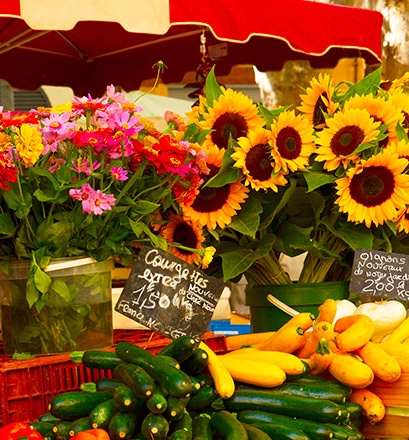
Mediterrane Lebensart
Weiße Kalksteinfelsen, sanfte grüne Kiefern, die die Klippen zieren, ein wolkenloser blauer Himmel... Wer viel reist, erkennt die typischen Landschaften des Mittelmeers auf den ersten Blick./p>
Mit ihren bunten Farben und verschiedenen Gerüchen, je nachdem, ob man von Lavendelfeldern oder Olivenhainen umgeben ist, durch von Orangenbäumen gesäumte Straßen schlendert, in kristallklares Wasser eintaucht oder auf einem Markt voller Köstlichkeiten verweilt, bieten die mediterranen Landschaften ein einmaliges Erlebnis für die Sinne. Lassen Sie sich vom Duft der Blumen verführen, verkosten Sie lokal angebautes Obst und Gemüse oder die vielen Honigsorten, die die Vielfalt der Flora widerspiegeln. Auf den beladenen Marktständen kommt der Farbenreichtum besonders eindrucksvoll zur Geltung, aber auch im Lächeln der Menschen und in den unterschiedlichen Akzenten. Auf unvergleichliche Weise lädt das Mittelmeer dazu ein, einen Gang herunterzuschalten, die süße Lebensart, die köstliche Küche, die Menschen, die mit ihren Händen sprechen, und die Sonnenstrahlen, die die Haut umschmeicheln, zu genießen.
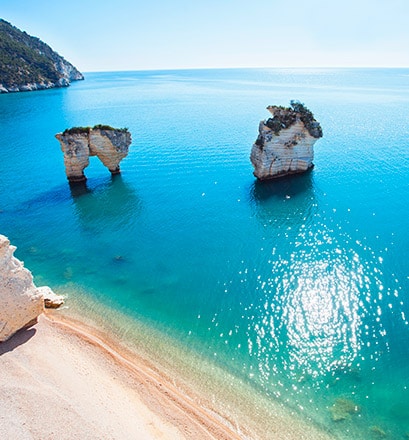
Schnittstelle der Zivilisationen
Vom Ufer der iberischen Halbinsel bis zur türkischen Küste ist das Mittelmeer die Schnittstelle zwischen verschiedenen Kontinenten. Über die „Badewanne Europas“ konnten die Menschen Verbindungen zwischen dem Orient und dem Westen herstellen, über die Landesgrenzen hinausblicken, Neues entdecken und Wissen und Waren austauschen.
Dank des Mittelmeers konnte sich ein außergewöhnlicher Schmelztiegel der Kulturen entwickeln. Kleine Häfen mit byzantinischer Architektur, alte osmanische Städte, Überreste der Römer und Griechen, spanisch-maurische Paläste... Vom Schwarzen Meer über die Adria und die Ägäis bis hin zur Straße von Gibraltar gibt es trotz der vielfältigen Einflüsse eines, das die Menschen auf besondere Art und Weise miteinander vereint: das hochgepriesene Savoir-Vivre.
Die schönsten Highlights des Mittelmeeres
Angesichts der vielen Facetten des Mittelmeers ist es nicht einfach, bestimmte Regionen gegenüber anderen zu bevorzugen. Wir haben einige Highlights im Mittelmeer zusammengestellt, von Besichtigungen kultureller Stätten bis hin zu Orten der absoluten Entspannung, die man zumindest einmal gesehen haben sollte.
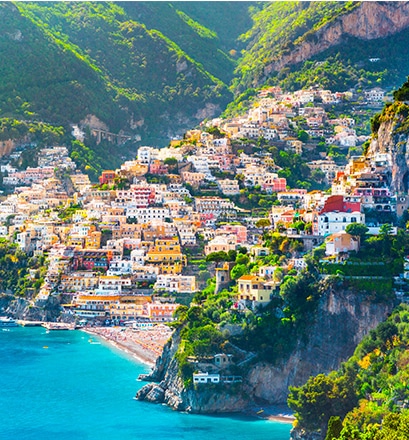
Die Amalfiküste
Die seit 1997 zum UNESCO-Welterbe zählende Amalfiküste ist eines der schönsten Juwelen Italiens. Ihre malerischen Dörfer wie Amalfi, Ravello und Positano, die sich sanft an die Hügel schmiegen, ihre grünen Klippen und die duftenden Zitronen-Terrassen haben sie weltberühmt gemacht.
Der Legende nach wandelten die Götter des Olymps den Pfad hoch über der Küste entlang, um dem Gesang der Sirenen zu lauschen. Von dort aus überblickten sie den gesamten Golf von Salerno bis zu den Felsformationen Capris und zum winzigen Archipel Li Galli, von wo die zauberhaften Stimmen kamen.
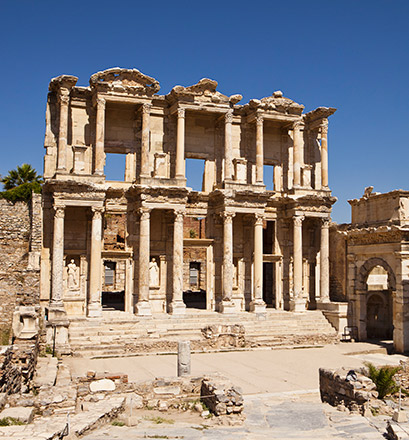
Das antike Griechenland
Als herausragende Seefahrer, unerschrockene Entdecker und geniale Baumeister errichteten die alten Griechen bereits ab dem 5. Jahrhundert v. Chr. beeindruckende Bauwerke in der Mittelmeerregion. Die Akropolis von Athen ist sicherlich das berühmteste Beispiel, doch auch die Schätze der Peloponnes wie das Theater von Epidauros spiegeln das Genie dieser herausragenden Architekten wider. Das majestätische Theater besticht durch seine vollendete Akustik und Harmonie. Mehrere hundert Kilometer entfernt zeugt die Ruinenstätte Ephesos in der Türkei, die der Göttin Artemis geweiht war, vom einstigen Reichtum der alten Hafenstadt, die nach Epidauros das zweitgrößte antike Theater der Welt beherbergt. Es bot Platz für 24.000 Zuschauer.
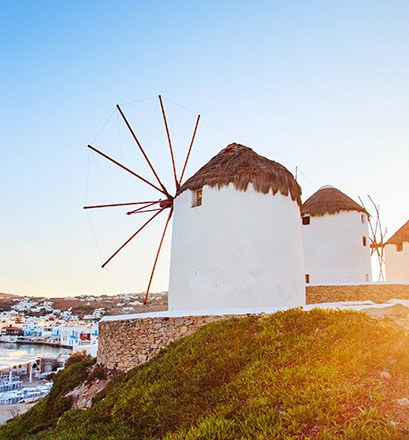
Das paradiesische Griechenland
Wer kennt sie nicht, die traumhaften Bilder der weiß getünchten Häuser, der makellosen Dörfer, die mit leuchtenden königsblauen Akzenten versehen sind? In diesen Fischerdörfern, die einen herrlichen Blick bis zum Horizont bieten, scheint die Zeit stillzustehen. Bewundern Sie von den Hügeln Santorinis aus einen Sonnenuntergang über dem Meer, genießen Sie die Traumstrände von Mykonos, schlendern Sie durch die engen Gassen der kleinen Insel Hydra, auf der keine motorisierten Fahrzeuge erlaubt sind.... Die schönsten griechischen Inseln bieten einen idealen Rahmen zum Abschalten und Genießen.
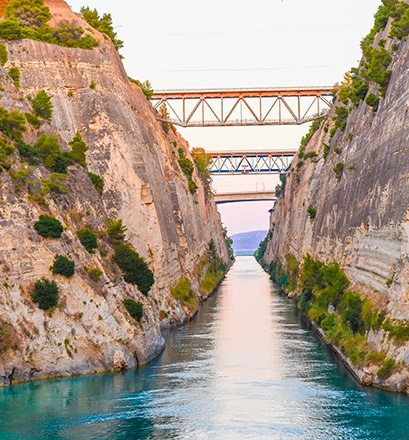
Fahrt durch den Kanal von Korinth
Der Kanal von Korinth durchtrennt den gleichnamigen Isthmus und macht die eigentliche Halbinsel Peloponnes zur Insel, indem er sie vom griechischen Festland abschneidet. Der 1893 eingeweihte Kanal hat eine Länge von etwas mehr als sechs Kilometern und ermöglicht es Handels- und Kreuzfahrtschiffen mit einem Tiefgang von unter acht Metern den 400 Kilometer langen Umweg um die Halbinsel zu vermeiden. Auf beiden Seiten des Kanals erheben sich ockerfarbene Felswände von bis zu fünfzig Metern Höhe. Beobachten Sie an Deck, wie Ihr Schiff durch diese schmale, in Felsgestein gegrabene Wasserstraße fährt: ein unvergessliches Erlebnis!
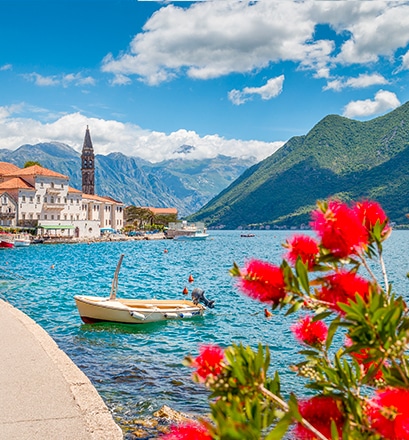
Die Dalmatinische Küste
Lassen Sie sich vom leichten Lebensgefühl der kleinen Küstenstadt Hvar verzaubern, besichtigen Sie das von Festungsmauern umgebene Dubrovnik, die „Perle der Adria“, oder die befestigte Stadt Split. Nach der Erkundung der Altstädte lädt das kristallklare Wasser zum Baden ein. In Montenegro entfaltet die Bucht von Kotor ihre faszinierende Landschaft, die mit traditionellen Dörfern und einer Reihe von wunderschönen Buchten aufwartet. Vor der Kulisse bewaldeter Hügeln bieten sie eine schöne Gelegenheit zum Schwimmen.
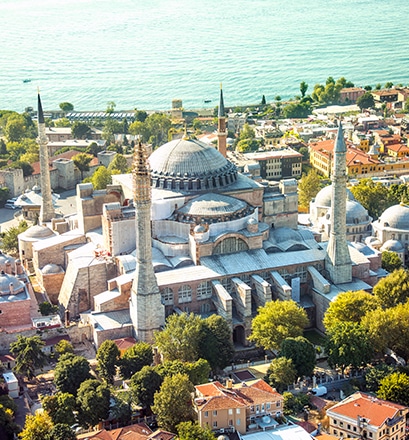
Istanbul
Lassen Sie sich vom betörenden Charme Istanbuls, des ehemaligen Byzanz und Konstantinopel, in den Bann ziehen. Wie in keiner anderen Stadt verschmelzen im heutigen Istanbul griechische, römische und ottomanische Einflüsse, die die Stadt im Laufe der Zeit geprägt haben. Der Topkapi-Palast, die Blaue Moschee, die Basilika Hagia Sophia und der Große Bazar mit seinen vielen Geschäften sind nur einige der schönsten Sehenswürdigkeiten Istanbuls. Eine faszinierende Hafenstadt, die zur Entdeckung des Bosporus und seiner reich verzierten Holzpaläste einlädt.
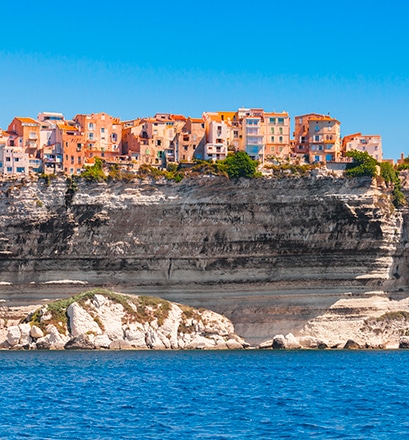
Bonifacio
Das auf einer Klippe gelegene Bonifacio an der Südspitze Korsikas ist eine mediterrane Festungsstadt mit einem atemberaubenden Blick auf das Meer. Als bedeutende Hafenstadt profitierte Bonifacio schon immer von seiner privilegierten Lage, die sich ideal für den Handel mit dem übrigen Mittelmeer eignete. Lange war die Stadt als strategischer Knotenpunkt zwischen Italien und Frankreich heiß begehrt, sodass die Reiche von Genua und Pisa die Stadt für sich beanspruchten. Heute bezaubert die südlichste Stadt des französischen Mutterlandes mit ihrer idyllischen Umgebung. Verborgene Buchten, ein schöner Hafen und Spaziergänge in der umliegenden Natur machen sie zu einer lohnenswerten Destination im Mittelmeer.
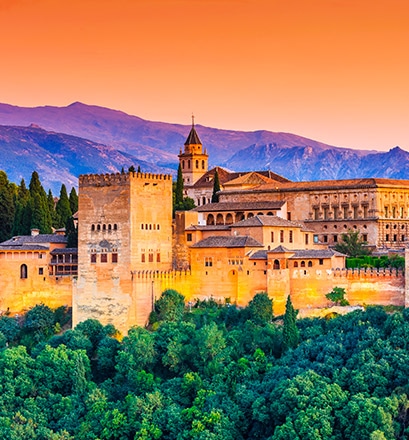
Die Alhambra
Nicht umsonst machen sich all die in Malaga vorbeikommenden Kreuzfahrtgäste auf den Weg ins Landesinnere! Etwa 120 Kilometer entfernt befindet sich die schöne Stadt Granada, die mit ihrem nicht minder atemberaubenden Alhambra-Palast beeindruckt. Er wurde 1238 von Mohammed ibn Al-Ahmar erbaut und zeugt von der muslimischen Präsenz in Spanien vom 8. bis 15. Jahrhundert. Erkunden Sie Raum für Raum und dringen Sie bis ins Herz der Nasridenpaläste und zum berühmten Löwenhof vor. Das architektonische Schmuckstück besticht mit kunstvollem Stuck, Arabesken und Säulen. Die Partal-Gärten mit dem Damenturm und dem Schwimmbecken sind einzigartig. Victor Hugo schrieb über diesen magischen Ort: „Die Alhambra! Die Alhambra! Ein Palast, von Genies vergoldet wie ein Traum und gefüllt von Harmonie“ (Orientales, 1828).










